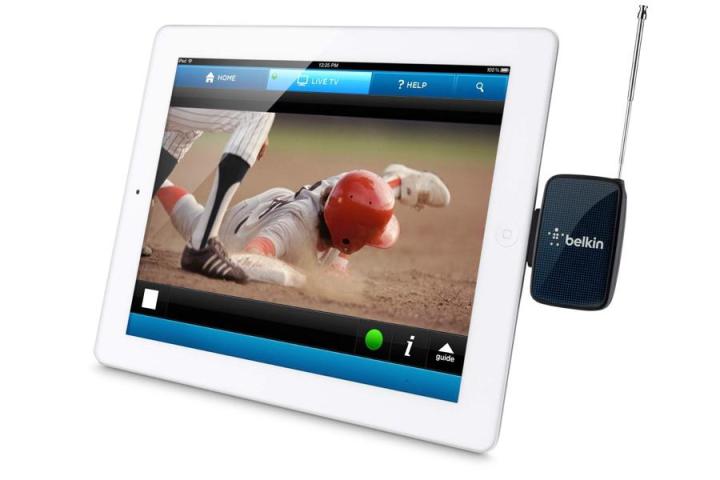
Between cable and satellite provider apps, network apps, and services like Aereo, there are many ways to watch TV on your iPad or iPhone outside of the home. All of these methods require an Internet connection and, in the case of Aereo, the layout of money for what is technically free. While it’s true that you get more with Aereo than just the ability to watch local TV (the DVR is pretty sweet), it’s still another monthly fee. Over-the-air broadcast channels only require an antenna to watch, be it on your TV or on an iPad.
The Belkin Dyle Wireless Mobile TV Receiver costs $100 and works with the free Dyle TV app for iOS devices. With it plugged in, you can watch local channels on your phone or tablet, no Internet connection required and no data used. Sounds great, right? That is until you get into the details.
Upfront, let us say that the receiver definitely works and it’s easy to set up. Download the app, enter your location, plug in the receiver, start watching TV. We were able to do so with the Wi-Fi on our iPad turned off. Not surprisingly, even after hours of watching the battery didn’t lose much juice. We also like that, other than the cost of the receiver, you don’t have to pay anything for this service. This product works. Unfortunately, that’s not necessarily enough.

Dyle TV isn’t exactly the same as Aereo. Depending on your location, you might not be able to use the service at all. In areas where the service is active, you probably won’t see all of your local channels listed in the app. That’s because Dyle will only show you channels the company has a partnership with in your specific town. The media company behind Dyle is owned by a group of broadcasters who are far more concerned about stepping on the toes of other broadcasters than Aereo.
In New York City, our testing area, Dyle only shows five channels: Fox, WNYE, NBC, Qubo, and Telemundo. Aereo shows 32, which includes the big five, local PBS, all major Spanish-language channels, and plenty more. All of these channels can be picked up by the Belkin receiver, but Dyle will not show them. The number of channels varies from place to place; check the coverage map before you consider purchasing this. In some areas all of the major networks are available, in others there are fewer even than we get in NYC.
Say you are in an area where Dyle offers enough local programming that you feel buying the receiver is a good investment. The next hurdle is hardware-based. The device only works on iOS devices with the old 30-pin connector. Granted, there are still a ton of second and third generation iPads out there and even more iPhone 4 and 4S handsets around. If you have a fourth-gen iPad, iPad Mini, iPhone 5, or any new iOS device going forward, you can’t use this product. Even if you get a Lightning adapter, it will not work according to Belkin.
These drawbacks don’t render the Dyle Wireless Mobile TV Receiver completely useless, it just makes it a very niche product. We can see buying this if you have an older iPad you want to keep useful or for emergencies. If power goes out and you can’t connect to the Internet via mobile broadband, the receiver will still work as long as your iOS device is charged and you can still get emergency information from local news. Otherwise, this accessory has a pretty limited use. If Dyle expands its coverage and starts showing more channels the value proposition may go up.


